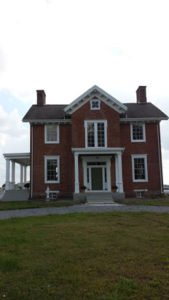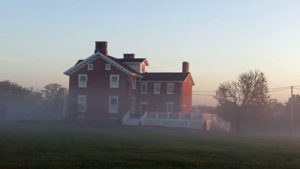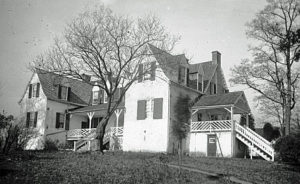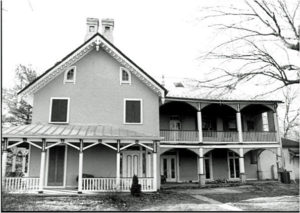by “My Father’s Son”
The Immaculate Collection: Hayland
Outside Emmitsburg, nearly the northernmost one can travel before leaving Maryland for Pennsylvania, stands a mansion time forgot, nestled at the end of a long, private lane in solitude, possibly its savior. This estate, known as “Hayland,” located at the terminus of Mechanicstown Road, off the way to Motter’s Station, is a large, brick, Italianate-mansion oriented to face the 25-foot golden statue of the Virgin Mary atop the 95-foot bell tower at Mount Saint Mary’s Seminary. The mansion consists of a “main block” with a lesser-scale wing extending from the rear façade. To begin the study of Hayland, however, the origins of Mount Saint Mary’s (MSM) must first be discussed.
Hayland, sharing borders with the prominent Elder property that held the mansion “Clairvaux” and original Elder home “Pleasant Level,” is in fact the original site of the Catholic college MSM (originally called Chinquopin), where Father John DuBois built a home for himself and a classroom building on land acquired from the Elder family. The fact that Hayland is the original site of MSM also likely explains the presence of a 12-seat privy removed from the property during mid-twentieth century ownership, of which the seat board has been found in a barn on the property. Come 1808, the Catholic Church required DuBois’s relocation of the school to the present MSM campus, sited on the face of Elder’s “St. Mary’s Mount” for better recognition and majesty. DuBois’s land was sold back to the Elder family. Joseph Elder, either the son or grandson of the original Elder, William, then resided at DuBois’s former home built c.1805 or earlier as found by dating of the floor planks still existing in the structure.
In 1846, Joseph Elder, of old age and poor health, moved with his wife to Ohio to live with family, presumably one of his children, and sold the small DuBois home to William Miles, a New York native born to George H. Miles, the son of Colonel Thomas Miles. William’s wife, Sarah “Sally” Mickle, was the daughter of Baltimore’s Robert Mickle and Philadelphia’s Jewish Elizabeth Etting. After purchasing the DuBois home, William Miles, a successful shipping merchant, contracted Emmitsburg Master Carpenter Joshua Shorb (responsible, too, for the later Gothic-remodel of the nearby Georgian-home, “San Marino”) for the hefty sum of $5,000 to enlarge the home purchased from Joseph Elder. The proper, “main-block” of the house at Hayland today is the addition commissioned by the Mile’s family. The Mile’s portion of Hayland is incredibly of post-beam construction, built like a barn of four-by-four members, secured with wooden pins and cross bracing and completely absent of nails. This stately addition is scaled as a manor of its time should be, with 9-foot, 6-over-9 sashes in areas of the first floor (the larger lower sashes sliding upward over the top portions and into a wall pocket, allowing the windows to act as doorways onto a grand, covered, side porch when open). This new, grand home, center-hall in plan, had four bedrooms upstairs and a small, center chapel at the top of the stairs with floor-to-ceiling windows facing MSM’s Grotto. The Miles addition was joined to the original DuBois home by a porch system, leaving the original home as a semi-detached structure operating as a kitchen and servants quarters to the proper Miles manor. The Miles family operated the Hayland plantation with immigrant as opposed to slave labor, documented by the 1860 Census, where in addition to Mr. and Mrs. Miles, Sally’s mother, and the Miles children, were four German field hands and two house servants also recorded. In the late 1800s, the porch between the two structures was enclosed, creating a “back-foyer” to the mansion, toting a final, third staircase when added to the formal front-stair (winding from the basement to the attic level) and primitive stairway left in the DuBois section of the now unified home.
“You had this enclave of very bright, gifted, people that carved out their own cultural center at the edge of the wilderness—a very close-knit community with close ties to Mount St. Mary’s” states Hayland’s current owner, speaking of the original Elder property which came to be divided between the Shorb, Manning, Tiers, and Miles families, all wealthy, well-connected devout Catholics attracted by MSM.
William and Sally Miles’ eldest son, George Henry, “the poet of the mountain” named after his paternal grandfather, is responsible for christening his parents’ home “Hayland.” A poet, novelist, and dramatist, George Miles was an MSM alumnus and English instructor at his alma-mater. At the age of seven, George Miles was placed in the care of Monsignor John McCaffrey, president of MSM, when his parents left the country for an extended diplomatic assignment in Haiti. McCaffrey became George’s godfather and mentor for the remainder of his life. (The Mile’s daughter, Elizabeth, was sent to St. Joseph’s in her parent’s absence.) In line with Hayland’s community’s focus around MSM, Elizabeth wed MSM Mathematics Professor Col. Daniel Beltshoover, and George Ms. Adeline Tiers—the daughter of his MSM classmate, Edward Tiers—both couples resided at Hayland at one time or another.
In 1872, Sally Miles, noted at the time as being “of Baltimore,” sold the stately Hayland holdings, spurring the start of several inhabitants over the next 134 years. The home was long owned by Daniel F. Roddy, owner of the surrounding Clairvaux and San Marino properties (the latter of which his personal residence) and used the Hayland mansion to house farm-managers and various farm hands, who assisted in the Roddy enterprises, utilizing the accumulation of his joined properties. Roddy’s deed lists the Mechanicstown Road property as “Hayland: Parts of the tracts ‘Elder’s Choice,’ ‘Pleasant Level,’ ‘Turkey Hill,’ ‘Enlargement,’ ‘Ramsey Rest,’ ‘St. Mary’s Valley,’ and ‘Buck’s Forest.” In 1940, Roddy’s heirs conveyed Hayland to the Long family, who also rented out the property, first as an entire house and then as divided apartments in the 1980s. In the hands of lifelong bachelor, Jay Clarence Long, who left Hayland to Trinity United Methodist Church of Emmitsburg in 1999 “to be kept, maintained, and disposed of in ways to benefit the church.” Hayland was again sold into private hands in 2006.
Enter the current owners who moved into Hayland only six weeks ago, after masterfully restoring the home for the past ten years. The new family, the first owners to own and reside in the Hayland home since 1900, have restored the home to its near 1850 condition, disguising the homes modernization to keep with its original fashion. Fortunately, much of the home’s original fabric remained intact because of the home’s longtime tenement use, excepting the removal of the two rear stairways to accommodate bathrooms and a second kitchen when converted to apartments.
Hayland’s lengthy restoration—an exciting and stressful time for the owners—was perhaps prolonged by fate to allow the admirable salvation of many comparable Joshua Shorb-features from San Marino to be used in Hayland’s repair. Marble mantles, wood trimmings, doors, fireplace-flanking, built-in cabinetry (the asymmetrical units ironically fitting perfectly alongside Hayland’s flues), a claw-foot tub, matching floorboards, and other features, allow the demolished San Marino to live on as part of Hayland. Also removed, spared from the complete destruction at San Marino, was the gothic privy-house, which made the short, quick journey across Motter’s Station Road to Hayland, where it will be refurbished into a pool-house. An oil painting of a lake and whooping cranes signed by a Marhia Van Der Zubér and dated 1893 was found beneath layers of drywall compound over a mantle between windows, overlooking the area in which the scene depicted once existed at Hayland.
Members of the Miles, Mickle, and Etting families are all buried at Hayland’s nearby Saint Anthony’s Catholic Church cemetery, all prominent families whose lineages have seemingly vanished. Hayland’s current owners, who also have family in the cemetery, have taken it upon themselves to repair and maintain their Hayland family’s resting places. Many thanks go out to Hayland’s new residents, without whose generosity to open their home to the author and share their extensive research, this edition would not be near as informative—they state with pride “we feel that we have restored Hayland to a place that the Miles family could return and once again recognize.” The property, slated for residential sub-division before the current purchase, has been placed in a state of agricultural preservation to secure Hayland’s future.
Follow remembering_frederick on Instagram for more Frederick County History and photographs.

The restored Hayland Mansion outside Emmitsburg. The “main-block” front façade built by Miles family c. 1850.

The right side façade of the Hayland Mansion, exquisitely depicting the scale between the Miles “main-block” and the original DuBois house that is now the manor’s rear-wing.



